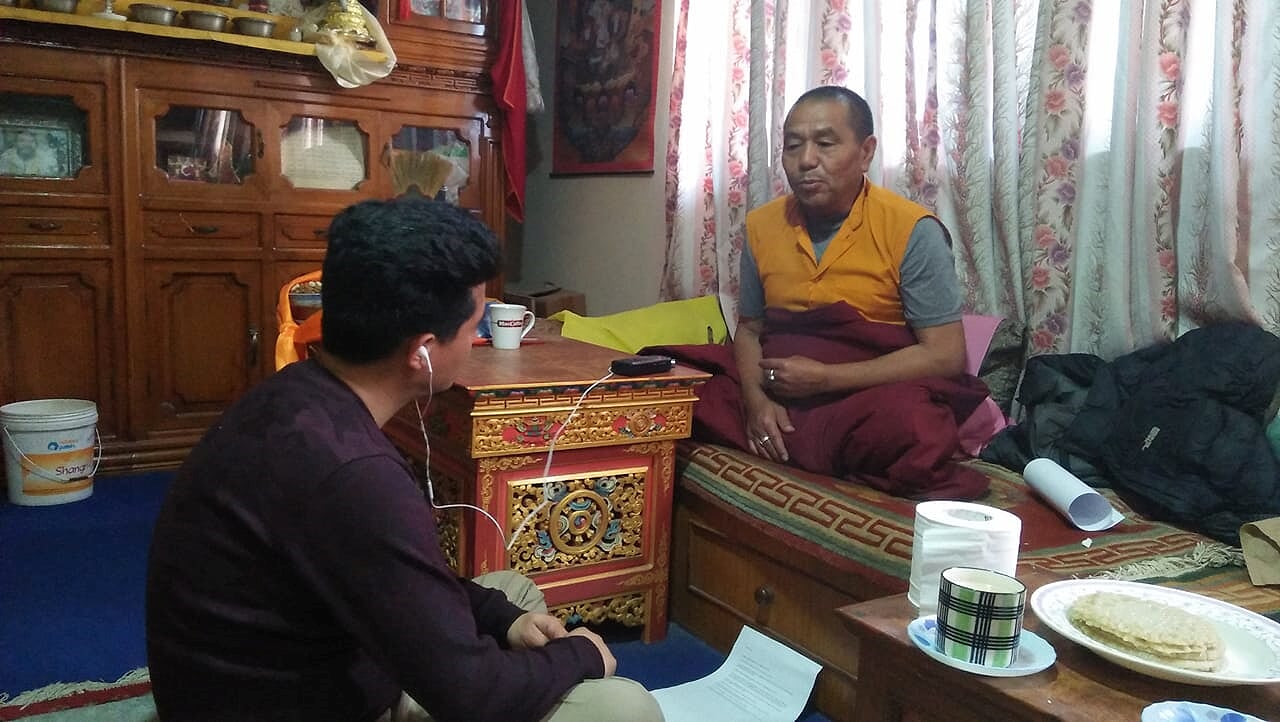
Zsóka Gelle
Researcher
gzsoka@gmail.com

Gen Dawa, my teacher at the Manjushree Institute in Darjeeling, India, where I was studying colloquial Tibetan in 2005, suggested that I visit Aloobari village outside Darjeeling if I wanted to understand the Hyolmo people and the text I had acquired just days earlier. I was fascinated by Tibetan stories about “people who returned from hell” (‘das log), and I had been working on translating one such story, ‘Das log Lha mo lham bcung. The main character of the story lived in Nepal, near the Tibetan border, in the Helambu region. A small group from this area had migrated to Darjeeling in the 1910s and established their own temple village, Aloobari. Eager to learn more about the people of Hyolmo and the context of my text, I set out for Aloobari.
There, I was introduced to Nyima Chogyal, a retired principal and passionate supporter of preserving Hyolmo culture. He was so enthusiastic about sharing his knowledge that I began spending my Saturdays at his home in Aloobari, listening to stories of a faraway homeland he had never seen. He was one of the last in the village who could still speak the Hyolmo language, as most of the younger generation spoke Hindi and Nepali. A few months later, as the Darjeeling Carnival approached—a festival where local ethnic groups showcase their cultural heritage—Nyima Chogyal expressed concern over which songs the community should perform, fearing there would be no one to remember the lyrics. Since I was planning to visit Kathmandu, he asked me to go up to the Hyolmo region and record some songs for his people.
What started as an eight-day trek in Helambu to collect songs and film sacred places for my Aloobari friends soon became a long-term passion and deep interest. In the summer of 2006, accompanied by Sangye Lama of Bremang, an excellent Yolmo trekking guide, I visited several significant locations: the Milarepa cave, Melamchighyang, Tarkeghyang, Gotsangling, Gangyul, and Sermathang. Local lamas generously shared their knowledge with me, some even lending me texts on Yolmo history to photocopy. Despite the challenges posed by the monsoon and the countless leeches, I was deeply moved by the beauty of Hyolmo and the generosity of its people.
In 2010, I returned to Yolmo for a month as a volunteer teacher at the Gangkharkha school, where I stayed with a family in the village. This experience allowed me to immerse myself in the daily lives of the villagers and learn about both Buddhist and shamanic practices firsthand.
The following year, in 2011, I applied for a PhD course at the University of Vienna and became a member of the Doctoral College for Cultural Transfers and Cross-Contacts on the Himalayan Borderlands. It was an enriching experience to work in an academic setting, studying methodology while conducting extended fieldwork in Hyolmo. I was captivated by every aspect of Hyolmo culture, gathering extensive material on its history, religious practices, mountain cults, clans, songs, and dances. My dissertation ultimately focused on sacred geography, Tibetan texts on Beyül (hidden lands), and the history of Buddhist lineages in Hyolmo. Along the way, I made many friends, received teachings from generous lamas, and came to realize how much more there was still to learn.
In 2015, while working as a Khyentse Fellow at ELTE University in Budapest, Hungary, and leading the Buddhist Research Centre, the earthquake struck Nepal. I immediately rushed to Hyolmo to assess how I could help. The devastation was overwhelming, and after much thought and discussion with friends, I concluded that the best way I could contribute was to establish a website to preserve and share the community’s memories and knowledge. In 2016, Dorje Wangchuck and Mingur Lama joined me, conducting several interviews with members of the Hyolmo community, and we launched the Hyolmo Heritage Project. Sixteen interviews conducted in the Hyolmo language, along with their English translations, have already been uploaded to the website. In 2017, Lama Sherab Tharchen also conducted interviews with lamas about the Buddhist history, practices, and Chatral Rinpoche’s activities in Hyolmo. These interviews will be available soon.
If you have any stories, photos, videos, or music related to Hyolmo that you’d like to share, please don’t hesitate to contact us at hyolmoheritage@gmail.com. We would be happy to add your contributions to the website. Thank you!

Dorje Wangchuck


Mingur Lama


Lama Sherab Tharchen

Life is not only about happiness; suffering is also an inevitable part of it. There’s a story I particularly like, and I’d love to share it with you.
Once, there were two women—one named Black Nose and the other named Lucky. Wherever Black Nose went, misfortune seemed to follow her. Wherever Lucky visited, good fortune followed in her wake. People would eagerly welcome Lucky, but no one wanted to be around Black Nose. Yet, despite their differences, the two women were the best of friends. They were inseparable, like two sides of the same coin.
If you wanted to have Lucky with you, Black Nose would inevitably come along as well. So, embrace them both, for they are two parts of the same journey.
